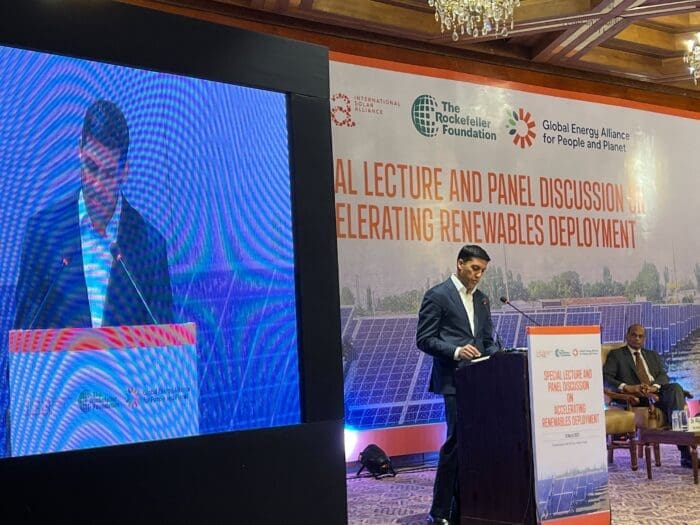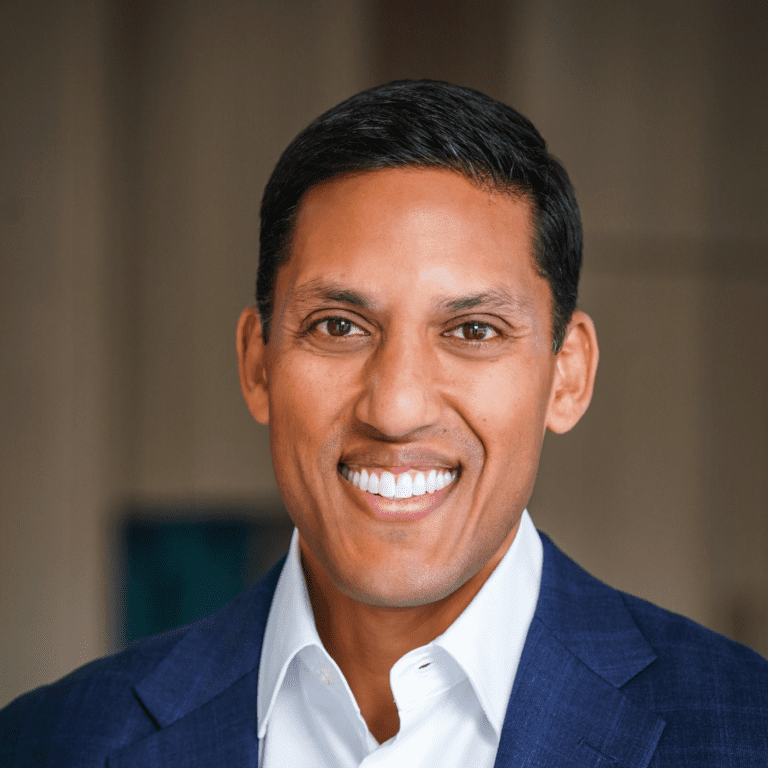As delivered on Monday, March 20, 2023, in New Delhi, India

Today’s session is all about continuing the long line of conversations between The Rockefeller Foundation and entities and leaders in India.
I’m always struck when I get a chance to come visit India — which I haven’t had a chance to do because of Covid for the last 3+ years — at how long our relationship goes back. 100 years ago, we have notes of Rockefeller officers visiting and speaking with medical scientists and public health professionals and institutions here in India. 60, 70 years ago, we helped invest, of course, in agricultural research and a series of institutions and “Rocky Docs” that helped our modernization of agricultural productivity in parts of South Asia and around the world. And in recent years, we’ve been able to collaborate on everything from Covid vaccination access to the creation of rapid PCR tests, which they gave me yesterday. And I’m negative, so that’s good.
But in recent years, the most important new frontier we’ve embraced is the power of renewable energy technology to be a force for lifting humanity and addressing the inequities that really remain stark and present in India and in so many other parts of the world. So, I’m glad that we get to have this conversation today.
I want to mention that this concept of leveraging renewable energy technologies to address inequity, or to create truly inclusive growth in the Indian economy, was a concept that was first introduced to me when I was the administrator of USAID working with President Obama many years ago. And Prime Minister Modi had just gotten elected and had come to have a dinner with us at the White House. And I was a last-minute addition to the dinner. But the Prime Minister said he was well aware of work we were doing in Africa on renewable energy and access to technology. And he said, “I see what you’re doing in Africa. You should be part of helping to build those same types of alliances in India, because we have the opportunity to really use access to renewables to drive inclusiveness in society that far outstrips anywhere else in the world.”
And I think that’s very true. And in fact, that led to some collaborations that were government to government. Government to government is always great. I’m going to try to make the case today that in order to really be successful under Simon [Harford] and Saurabh’s [Kumar] leadership, we actually need public-private alliances. And that’s what the Global Energy Alliance for People and Planet in India will hope to build.
So, when we started this work at The Rockefeller Foundation, solar panels were hard to get, batteries were expensive, smart meters didn’t really exist. Mobile payments were an idea but not practically deployed in the context of bringing renewable energy to lower-income segments. And you have made tremendous progress. Just since 2010, the cost of solar PV has fallen 88%, the cost of residential solar has decreased 56%, the cost of residential solar here in India is about 80% lower than it is in the United States. So, there’s tremendous opportunity now to scale access to things that should be low cost, should be high volume, should be “frugal innovation” concepts on the frontiers of the renewable energy technology revolution.
The government, of course, has made big commitments towards 100% electrification, I think, at both the village level and the household level, although you are the experts as to how close to that objective the country has come. And I will just say, and I know Simon thinks about this a lot, India has the potential in the development of solutions for energy storage, for renewables, for metering, for energy management, battery management, utility grid improvement — in all of those areas, innovations from this economy should transform access to renewable electrification in 80 other countries around the world. Because India is perhaps the only country that has the scale, the capacity, the private sector, the innovation engine, and the policy oversight to drive aggressive access to renewable electrification in the manner we’re describing here.
And that’s important because at the end of the day, on a global basis, we are falling behind. 775 million people still live, effectively, completely in the dark. 3.6 billion people — almost half the world’s population — live in 81 energy-poor countries. We include India in that 81 — at under the 1,000-kilowatt hours per year per capita threshold that we believe is the true threshold for assessing whether energy access drives inclusive growth or not. And I know that’s a different definition than the UN definition of “energy poverty,” but it’s the one that we believe is more instructive towards the goal of creating inclusive growth and development.
We asked ourselves, well, why is renewable energy still so inaccessible in so much of the world? 6% of solar PV and wind additions in 2021 were rolled out in the 81 countries we are describing and only 0.6% in Africa. And I think we’ve concluded — although Simon, correct me if I’m wrong — there are about three reasons.
The first is that access to technology is still very constrained and inequitable. Whether it’s solar PV or batteries, the costs are much higher. Actual access to supply is much more constrained. We’re living in a world where, whether it’s raw mineral materials or supply chains based largely out of China, some elements of the renewable energy frontier are simply not accessible at price points that are viable, broadly, in the developing world.
The second is the cost of finance. And The Rockefeller Foundation has done a lot of work on the global economic recovery. The truth is, we are currently in the midst of unwinding decades of progress against the Sustainable Development Goals. Because of the debt costs, the food costs, the fuel and subsidy costs that have all skyrocketed for many emerging economies. As a result, more than 40 countries are facing acute debt crisis. There is no new liquidity in the public finance system. And as a result, the ability to access finance, and frankly, the risk attributed to most emerging market currencies, is much higher than it would have been in a different era — 5, 6, 7, or 10 years ago.
And third, government capacity remains limited. I think in India, probably that’s the exception — here, there’s quite a lot of capacity. But if you look around the world, the regulatory capacity, the ability to set goals, the ability to put in place the kinds of collaborations required to really break through, are hard to come by. And maybe in India, despite the high public sector capacity, I keep hearing that, particularly at the state level, it’s not all efficient in the deployment of that capacity towards these objectives.
So, what is the Global Energy Alliance set up to do?
The first is, I think it’s set up to create a high ambition. We should have a high ambition. And I know in India, Simon and Saurabh have a very high ambition. Because honestly, renewable energy access is probably the single greatest chance we have to create inclusive development in the 81 countries we’re defining. So, high ambition.
The second is, we should be working hand in glove with governments to set policies, set ambition, understand the use of subsidies, understand the use of public finance, understand how to create the incentives for large-scale access to renewables. And by the way, I love saying this because I feel so passionately about it — there’s no industrial nation on the planet that’s achieved universal productive energy access without deep government involvement and real public investment. So, the idea that somehow this should happen without governments is a huge mistake, in my view.
So, third, we should make sure the right technology is accessible. That might be pooled procurement, and GEAPP has done some innovative work in that space. That might be more analytics to understand what optimal target product profiles are for future grid storage technologies, etc. It might be innovation awards and other incentives that bring those technologies online more robustly. But access to technology has to be a critical component.
Fourth, blended finance. This will not happen without public and private investment working together. GEAPP has amassed about $11.5 billion of blended finance. $1.5 billion of that are from three foundations — it’s the grant money — $500 million each from Rockefeller, IKEA Foundation, and Bezos Earth Fund. We’d like to attract more grant money, more commercial investment, and more development bank commitments. But, you know, that’s where we are now and it’s what we have to work with.
And fifth is genuine alliance mindset. And I’ve been so impressed — I had the chance to spend time yesterday with sort of a community of many of you and others and just hear about how you’re addressing the challenges forward. And I just came away inspired that all the talent exists in these rooms. Can we really embrace an alliance mindset? And to me, what that means is all of us appreciating that you are the Global Energy Alliance for People and Planet. Your creativity, your willingness to share your thinking, your ability to commit your time and your institutions’ capacities to working together is how we will deliver success.
So, I will just say the last time I was here, just before Covid, I had a chance to visit Derni, outside of Patna in Bihar. And I met with a carpenter, who explained to me that he had — prior to having renewable access through one of the mini grids that Ashvin [Dayal] and his team and some of the others, I think that was an OMC [Power] grid, had built out — they were reliant on very, very unreliable government power. And he said with that alone, he was not able to invest in power tools or hiring people and was really running a sort of very, very basic operation. Once he had access to reliable, productive power, even though it was a little more expensive than any of us would like to sell power at to these communities, he was able to use it, able to buy power tools, able to hire three or four people.
And it was just good to see what inclusive development actually looks like, in a village, in a shop with employees who talk about the dignity that comes with the ability to work.
So, thank you for your efforts. I look forward to this conversation. And we’ll continue to try to enable more success through the Global Energy Alliance for People and Planet. Thank you.
# # #
